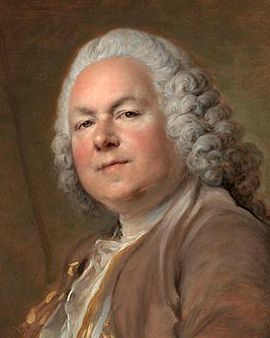


Jean-Marc Nattier was the second son of the artist couple Marc Nattier and Marie Courtois. He became famous for his paintings in which he depicted the ladies at King Ludwig's court in classical mythological dresses. He became famous in 1710 for engravings based on his drawings of Peter Paul Rubens' famous Medici cycle from the Palais du Luxembourg. Nattier received his first lessons from his father, who was a portrait painter, and his uncle, the history painter Jean Jouvenet. Later he became a student at the Royal Academy. Jean-Marc Nattier was already an extremely talented painter at a young age. He won the coveted prize of the Académie royal already at the age of 15. However, he rejected the trip to Rome which was connected with it.
Like his uncle, Nattier wanted to become a history painter. He devoted himself to this genre between 1715 and 1720, from which time he produced works such as "The Battle of Pultawa". This painting was commissioned by Peter the Great. For his admission as a full member of the Royal Academy he submitted the work "Petrification of Phineus and his companions". He was appointed professor at the Academy in 1752. Nattier travelled to Amsterdam in 1715 to paint portraits of the Russian Tsar Peter the Great and his wife. However, Nattier declined the Tsar's invitation to go to Russia. He was forced to give up his career goals of becoming famous as a history painter in 1720 due to the dramatic financial crisis in France. For Nattier, like many others, had lost almost his entire fortune. He had to look for more lucrative commissions. At that time this was especially portrait painting.
Nevertheless Nattier found a way to combine his passion with portrait painting. He introduced allegorical portrait painting, which soon became very popular with the ladies of the court. He transformed his models into mythological figures, such as ancient goddesses. Among others Nattier portrayed Empress Maria Theresa, all daughters of King Louis XV and his wife Maria Leszczynska. From the mid-1750s Nattier's fame began to fade. The art critic Diderot was one of Nattier's most severe critics and is said to have said about him in 1761: "Has this man no friend who will tell him the truth? Nattier was by now an old, frail man and was in financial distress. In the end he was forced to sell his art collection and his entire studio. Nattier's son, who had a great career as a painter, drowned in the Tiber during his studies in Rome.

Jean-Marc Nattier was the second son of the artist couple Marc Nattier and Marie Courtois. He became famous for his paintings in which he depicted the ladies at King Ludwig's court in classical mythological dresses. He became famous in 1710 for engravings based on his drawings of Peter Paul Rubens' famous Medici cycle from the Palais du Luxembourg. Nattier received his first lessons from his father, who was a portrait painter, and his uncle, the history painter Jean Jouvenet. Later he became a student at the Royal Academy. Jean-Marc Nattier was already an extremely talented painter at a young age. He won the coveted prize of the Académie royal already at the age of 15. However, he rejected the trip to Rome which was connected with it.
Like his uncle, Nattier wanted to become a history painter. He devoted himself to this genre between 1715 and 1720, from which time he produced works such as "The Battle of Pultawa". This painting was commissioned by Peter the Great. For his admission as a full member of the Royal Academy he submitted the work "Petrification of Phineus and his companions". He was appointed professor at the Academy in 1752. Nattier travelled to Amsterdam in 1715 to paint portraits of the Russian Tsar Peter the Great and his wife. However, Nattier declined the Tsar's invitation to go to Russia. He was forced to give up his career goals of becoming famous as a history painter in 1720 due to the dramatic financial crisis in France. For Nattier, like many others, had lost almost his entire fortune. He had to look for more lucrative commissions. At that time this was especially portrait painting.
Nevertheless Nattier found a way to combine his passion with portrait painting. He introduced allegorical portrait painting, which soon became very popular with the ladies of the court. He transformed his models into mythological figures, such as ancient goddesses. Among others Nattier portrayed Empress Maria Theresa, all daughters of King Louis XV and his wife Maria Leszczynska. From the mid-1750s Nattier's fame began to fade. The art critic Diderot was one of Nattier's most severe critics and is said to have said about him in 1761: "Has this man no friend who will tell him the truth? Nattier was by now an old, frail man and was in financial distress. In the end he was forced to sell his art collection and his entire studio. Nattier's son, who had a great career as a painter, drowned in the Tiber during his studies in Rome.
Page 1 / 3






